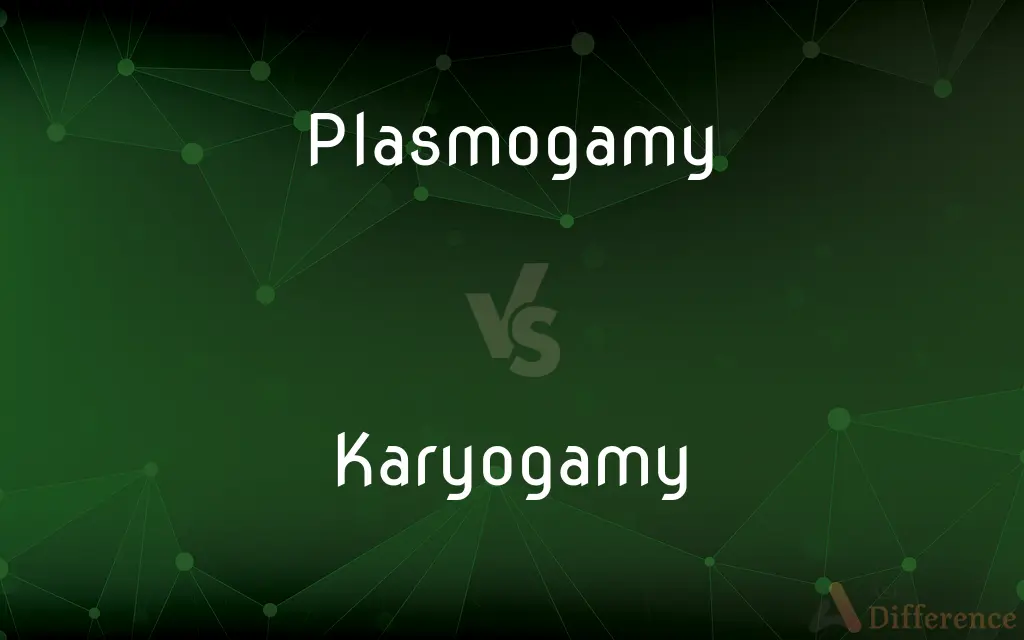Plasmogamy vs. Karyogamy — What's the Difference?
Edited by Tayyaba Rehman — By Fiza Rafique — Updated on March 20, 2024
Plasmogamy is the fusion of cell cytoplasms in fungal reproduction, while karyogamy involves the fusion of nuclei, completing the sexual cycle.

Difference Between Plasmogamy and Karyogamy
Table of Contents
ADVERTISEMENT
Key Differences
Plasmogamy represents the initial phase of fungal sexual reproduction where the cytoplasm of two parent cells merges. This stage is crucial for bringing together genetic materials from different cells. In contrast, karyogamy is the subsequent step where the nuclei of these fused cells combine, leading to the formation of a diploid zygote.
During plasmogamy, the cell walls of the participating fungal cells dissolve or merge, allowing their cytoplasms to mix without immediately merging their nuclei. Karyogamy, on the other hand, might occur immediately after plasmogamy or be delayed, resulting in a dikaryotic stage where cells contain two separate nuclei.
Plasmogamy does not result in the mixing of genetic material but sets the stage for it. Karyogamy completes the process, leading to the exchange and recombination of genetic material between the fused nuclei.
The outcome of plasmogamy is a cell or hyphal segment with merged cytoplasm from two parents, known as a dikaryotic or heterokaryotic state, depending on the fungal species. Following karyogamy, the zygote undergoes meiosis, leading to genetic variation in the resulting spores.
Plasmogamy and karyogamy are critical for fungal diversity and adaptation, allowing fungi to combine genetic traits from different strains or species and adapt to new environments or stresses.
ADVERTISEMENT
Comparison Chart
Definition
Fusion of the cytoplasms of two parent fungal cells
Fusion of the nuclei from fused fungal cells
Sequence
Initial phase of sexual reproduction
Follows plasmogamy, completing sexual reproduction
Genetic Mixing
Does not involve mixing of genetic material
Results in the mixing of genetic material
Outcome
Dikaryotic or heterokaryotic state
Formation of a diploid zygote
Role in Diversity
Sets stage for genetic recombination
Facilitates genetic diversity through recombination
Compare with Definitions
Plasmogamy
Merges the cytoplasm of two fungal cells.
In fungi, two mating types come together, and their cytoplasms fuse without merging their nuclei.
Karyogamy
The nuclei of the fused cells merge, forming a zygote.
Following plasmogamy, the separate nuclei within the dikaryotic cell eventually fuse during karyogamy.
Plasmogamy
A common step in the reproductive cycles of many fungi.
Both mushrooms and molds undergo plasmogamy during their life cycles.
Karyogamy
Enhances fungal adaptation through genetic recombination.
Karyogamy contributes to the ability of fungi to adapt to new environments by creating new genetic combinations.
Plasmogamy
Initiates the sexual cycle without immediate genetic mixing.
Plasmogamy leads to the creation of a cell with two distinct nuclei, setting the stage for karyogamy.
Karyogamy
Mixing of genetic material occurs, leading to variation.
Karyogamy is crucial for the genetic diversity seen in fungi, as it mixes the genetic materials from two parents.
Plasmogamy
Often results in cells with two separate nuclei.
Many fungi enter a dikaryotic phase after plasmogamy, where cells operate with two nuclei.
Karyogamy
The diploid zygote often undergoes meiosis to form spores.
The diploid zygote resulting from karyogamy typically enters meiosis, producing genetically varied spores.
Plasmogamy
Enables fungi to combine cellular components and potentially beneficial traits.
Plasmogamy allows fungi to prepare for environmental changes by bringing together diverse cytoplasmic contents.
Karyogamy
Can occur long after plasmogamy, maintaining a dikaryotic phase.
In some fungal species, the dikaryotic state can last for months or even years before karyogamy occurs.
Plasmogamy
Plasmogamy is a stage in the sexual reproduction of fungi, in which the protoplasm of two parent cells (usually from the mycelia) fuses together without the fusion of nuclei, effectively bringing two haploid nuclei close together in the same cell. This state is followed by karyogamy, where the two nuclei fuse together and then undergo meiosis to produce spores.
Karyogamy
Karyogamy is the final step in the process of fusing together two haploid eukaryotic cells, and refers specifically to the fusion of the two nuclei. Before karyogamy, each haploid cell has one complete copy of the organism's genome.
Plasmogamy
Fusion of the cytoplasms of two or more cells, as contrasted with fusion of the nuclei.
Karyogamy
The coming together and fusing of cell nuclei, as in fertilization.
Plasmogamy
(mycology) Stage of sexual reproduction joining the cytoplasm of two parent mycelia without the fusion of nuclei.
Karyogamy
(biology) The fusion of two nuclei within a cell, especially as the second stage of syngamy.
Common Curiosities
Can plasmogamy and karyogamy occur simultaneously?
While plasmogamy and karyogamy are sequential processes, karyogamy may not immediately follow plasmogamy; there can be a significant delay between them.
What happens after karyogamy in the fungal life cycle?
Following karyogamy, the diploid zygote typically undergoes meiosis to produce haploid spores, which can germinate and grow into new fungal organisms, completing the life cycle.
What triggers plasmogamy in fungi?
Plasmogamy is often triggered by environmental signals or the presence of compatible mating types, leading to the fusion of fungal cells.
Why is karyogamy important in fungal reproduction?
Karyogamy is crucial for genetic diversity and recombination, as it allows for the mixing of genetic material from two parent cells, leading to variation in the offspring.
Is plasmogamy unique to fungi?
While plasmogamy is a key feature in fungal reproduction, similar processes of cell fusion can occur in other organisms, albeit with different biological contexts and outcomes.
How do fungi benefit from a dikaryotic phase?
The dikaryotic phase can offer genetic flexibility and resilience, as two genetically distinct nuclei coexist, potentially combining beneficial traits from both parent cells.
What role do mating types play in fungal plasmogamy?
Fungal mating types determine compatibility for plasmogamy; only cells of compatible mating types will typically undergo plasmogamy, ensuring genetic diversity.
How do environmental conditions affect plasmogamy and karyogamy?
Environmental conditions such as nutrient availability, temperature, and moisture can influence the timing and success of plasmogamy and karyogamy in fungi.
How does genetic diversity from karyogamy benefit fungi?
Genetic diversity from karyogamy enhances the adaptability and survival of fungi, allowing them to colonize new environments and resist diseases.
Can karyogamy lead to immediate spore formation?
Karyogamy itself leads to the formation of a diploid zygote; spore formation usually follows meiosis, which occurs after karyogamy.
Are there fungi that do not undergo plasmogamy or karyogamy?
Most sexually reproducing fungi undergo plasmogamy and karyogamy, but some fungi reproduce asexually, bypassing these processes.
Share Your Discovery

Previous Comparison
Sportsmanship vs. Gamesmanship
Next Comparison
Had vs. WasAuthor Spotlight
Written by
Fiza RafiqueFiza Rafique is a skilled content writer at AskDifference.com, where she meticulously refines and enhances written pieces. Drawing from her vast editorial expertise, Fiza ensures clarity, accuracy, and precision in every article. Passionate about language, she continually seeks to elevate the quality of content for readers worldwide.
Edited by
Tayyaba RehmanTayyaba Rehman is a distinguished writer, currently serving as a primary contributor to askdifference.com. As a researcher in semantics and etymology, Tayyaba's passion for the complexity of languages and their distinctions has found a perfect home on the platform. Tayyaba delves into the intricacies of language, distinguishing between commonly confused words and phrases, thereby providing clarity for readers worldwide.














































